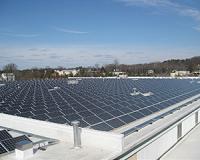 |
Ottawa (UPI) Apr 19, 2011 Solar power development is facing new challenges as efforts to introduce more organic components in solar power generation technologies are hampered by poor performance results. Organic photovoltaic modules using carbon instead of silicon or synthetic film are widely seen as an industry for future growth but so far have proven inefficient and costlier than conventional solar power generation units. This means that growth in the commercial uses of OPV modules will be slower than originally anticipated, said a new report. The report from Lux Research came as U.S. company Emerson announced a deal with Sanmina-SCI of Ottawa to build innovative solar power inverters for Canada's growing renewable energy program. Emerson will build the inverters at Sanmina-SCI's Ottawa manufacturing facility, meeting Ontario government requirement that technologies used in renewable energy projects be built in the province. The inverters convert DC power from photovoltaic arrays into AC power that can be placed directly on the electric grid. The Emerson grid-tie inverters to be built by Sanmina-SCI are designed for utility and large-scale commercial uses. Production of the inverters will begin this year and may also serve solar energy projects throughout North and South America, Emerson said. "Emerson is committed to providing high-quality technologies and services to the renewable energy market in Canada," said Mark Bulanda, president of Emerson's control techniques business and leader of the company's solar and wind initiatives. He indicated Emerson chose Sanmina-SCI because the two companies were well matched. Sanmina-SCI's experience in manufacturing complex technologies "matches our long-term experience in renewable energy innovations," Bulanda said. "Solar energy is a strategic initiative for countries worldwide and is an important growth market for Sanmina-SCI," said Tom Clawson, executive vice president of Sanmina-SCI's industrial markets. Emerson and Sanmina-SCI are participating this week in the second Ontario Feed-In Tariff Supply Chain Forum in Toronto, which brings together key industry players and regulators from wind and solar industries. Emerson has headquarters in St. Louis and reported sales of $21 billion in 2010. While conventional solar power development is growing worldwide, the Lux Research report suggests increased use of organic components in solar power production modules may be slower to adopt than anticipated. "OPV's comparatively poor conversion efficiencies and short lifetimes mean that it won't compete with conventional solar technologies, limiting its market potential," the report said. OPV modules use carbon-containing polymers or molecules to convert light to electricity. Conventional solar power production entails use of silicon or synthetic film. "While part of OPV's appeal is the hope of low costs, we found it won't beat crystalline silicon or inorganic thin film on cost per watt," said Alex Carter, a research associate at Lux Research and the report's lead author. Experts are hoping that more technologically savvy applications of organic materials will increase the use of OPV to generate power both for civilian and military uses, including soldiers' uniforms.
Share This Article With Planet Earth
Related Links All About Solar Energy at SolarDaily.com
 Solar Power Installation Online At Anne Arundel County's Combined Support Services Complex
Solar Power Installation Online At Anne Arundel County's Combined Support Services ComplexBaltimore MD (SPX) Apr 20, 2011 Constellation Energy has announced the completion by its retail energy business of a 750-kilowatt on-site solar installation at Anne Arundel County's Combined Support Services Complex in Millersville, Md. The installation is the first solar project to be operational under the Maryland Energy Administration's Project Sunburst initiative, which utilizes funds from the American Recovery and R ... read more |
|
| The content herein, unless otherwise known to be public domain, are Copyright 1995-2010 - SpaceDaily. AFP and UPI Wire Stories are copyright Agence France-Presse and United Press International. ESA Portal Reports are copyright European Space Agency. All NASA sourced material is public domain. Additional copyrights may apply in whole or part to other bona fide parties. Advertising does not imply endorsement,agreement or approval of any opinions, statements or information provided by SpaceDaily on any Web page published or hosted by SpaceDaily. Privacy Statement |